Tree Protection Against Deer: Protecting Newly Planted Trees From Deer
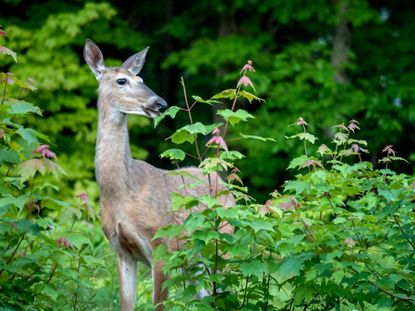

There is nothing more frustrating than noticing the bark is peeled away from newly planted trees. The damage is potentially life-threatening and exposes the not yet established tree to disease and pests. Deer are majestic and graceful but their feeding and rubbing hurt your plants. So if you are asking yourself, how can I protect baby trees from deer? The answers can be found in just a few sentences below.
Reasons to Protect New Trees from Deer
Watching wildlife is a peaceful and sentient activity. Deer are especially marvelous to view in the woods and fields but once they are in your garden, the gloves come off. Deer tree protection is necessary for many varieties of trees, as well as the newly planted babies up to a few years old. Deer have their preferences for nibbling, but young bark is especially appealing due to its flavor and tenderness. The worst damage is done by males who rub their antlers against the bark to remove the velvet. Deer also paw at the soil and unearth roots, damage the base of the small tree, and can even unearth newly planted trees. Protecting newly planted trees from deer in prone areas is necessary for their continued health and growth. So how can I protect baby trees from deer? This question has likely been asked since humans began to plant and agriculture became a way of life. The first step is to ascertain for certain who the culprit is of the damaged trees. If you actually see the deer with your own eyes, you will know -- but they are shy creatures and may not be evident when people are out and about. Rabbits and other rodents also do a fair bit of damage to young trees. Deer browsing leaves ragged edges on the bark and lower branches. They have oval droppings and the damage will be higher up on the plant than rodent damage.
Methods of Deer Tree Protection
There are two easy ways to protect new trees from deer. Repellents and barriers are both useful in many instances but the combination of the two is best, as deer are wily and can get over all but the tallest fences.
Cages and Fencing
Cages and fences cordon off the area where deer browse. A deer fence must be at least 8 to 10 feet (2.5-3 m.) high to stop the animals from leaping into the no browse zone. Fencing is expensive but fairly reliable. Cages can be constructed from chicken wire or more glamorous materials, but the goal is to encase the sensitive tree and prevent deer damage. Cages need to be expandable to allow for tree growth while still giving deer tree protection. Protecting newly planted trees from deer with repellents may use the animal's sense of smell or taste to drive it away. Homemade remedies abound on the internet or try a commercial repellent for tree protection against deer.
Get Cookin'- Homemade Recipes for Deer Repellent
Actually, you don't even need to touch a saucepan. Deer are offended by human scents such as bars of soap and hair. Hang these in old pantyhose from the tree limbs. Protect new trees from deer with sprays you can mix up at home. A solution of 6 percent hot sauce and 94 percent water or straight blended up habaneros at 8 percent and 92 percent water will offend the deer's sense of taste. They also seem to dislike chicken eggs mixed with water that's sprayed on the tree bark.
Collars for Tree Protection Against Deer
Very few trees can get adequate stem protection from a homemade collar. Use PVC piping large enough to fit around the trunk with a couple of inches (5 cm.) of room. Cut down the length of the pipe to open it up and slip it around the trunk at planting. Heavy mesh or inexpensive wire fencing is also useful. Roll pieces of these around the trunk and secure. Any type of collar you use will need to be staked and removed when the trunk grows too large for the enclosure.
Gardening tips, videos, info and more delivered right to your inbox!
Sign up for the Gardening Know How newsletter today and receive a free download of our most popular eBook "How to Grow Delicious Tomatoes."

Bonnie Grant is a professional landscaper with a Certification in Urban Gardening. She has been gardening and writing for 15 years. A former professional chef, she has a passion for edible landscaping.
-
 Grow a Bathroom Oasis: 8 Best Bathroom Plants With No Light or Low Light
Grow a Bathroom Oasis: 8 Best Bathroom Plants With No Light or Low LightSome apartment dwellers grow the best bathroom plants with no light or low light. Read how one of our favorite plant lovers does it in the big city.
By Teo Spengler
-
 "My Worst Mistake" – Gardeners Share 10 Hard-Learned Lessons
"My Worst Mistake" – Gardeners Share 10 Hard-Learned LessonsGardeners never stop learning, and sometimes our mistakes are the best teachers. But why not save time and heartache by learning from other gardeners' failures?
By Melanie Griffiths
-
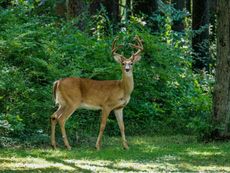 Deter Deer And Prevent Ticks By Getting Rid Of Honeysuckle
Deter Deer And Prevent Ticks By Getting Rid Of HoneysuckleWe don’t usually think of sweet-smelling honeysuckle as being unsafe, but the deer love it. and where there are deer there are often ticks. Read on for more reasons to avoid non-native honeysuckles.
By Mary Ellen Ellis
-
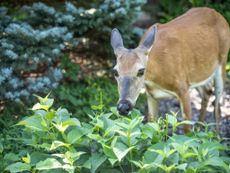 Deer Proof Shade Flowers: Choosing Deer Resistant Flowers For Shade
Deer Proof Shade Flowers: Choosing Deer Resistant Flowers For ShadeWatching deer move through your property can be a peaceful way to enjoy nature. However, they can become a nuisance if they start eating your flowers. If you have a shady garden bed, add flowers they will have no interest in. Click here to learn more.
By Mary Ellen Ellis
-
 Deer Droppings On Plants: Is Fertilizing With Deer Manure Safe
Deer Droppings On Plants: Is Fertilizing With Deer Manure SafeWhether you love or hate deer, or have a more complicated relationship with them, there is one important question to answer: Can you use deer manure in gardens? Click on the following article to find out more about fertilizing with deer manure.
By Mary Ellen Ellis
-
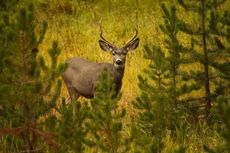 Deer Proof Evergreens: Are There Evergreens Deer Won’t Eat
Deer Proof Evergreens: Are There Evergreens Deer Won’t EatThe presence of deer in the garden can be troublesome. With some proven planting techniques, however, gardeners may be able to reduce the occurrence of damage caused by deer. Planting deer resistant evergreen plants, for example is one method. Learn more here.
By Tonya Barnett
-
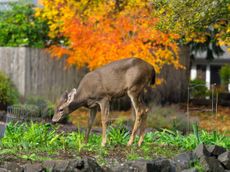 Deer Proof Gardening: What Vegetables Are Deer Resistant
Deer Proof Gardening: What Vegetables Are Deer ResistantThe best defense is a good offense. In deer proof gardening, plants that smell offensive to deer can deter them from their favorite edibles. Planting a garden with edible plants deer don't eat is also a defense. Click here for fruits and vegetables deer won't eat.
By Darcy Larum
-
 Deer Resistant Garden Plans – Creating A Deer Resistant Garden
Deer Resistant Garden Plans – Creating A Deer Resistant GardenDeer are lovely to watch but not when they are stomping all over your vegetable garden or eating the tops off of your bulbs. Creating a deer resistant garden is a must for any gardener who suffers from these grazing marauders. Learn more here.
By Bonnie L. Grant
-
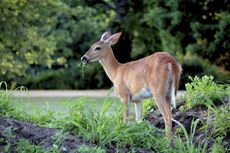 Roses And Deer – Do Deer Eat Rose Plants And How To Save Them
Roses And Deer – Do Deer Eat Rose Plants And How To Save ThemDeer do indeed love the beautiful, succulent growth they find in those meadows and valleys, but they cannot resist a rose garden if there is one close by. Learn how to fix deer damage and prevent more in this article. Click here for more info.
By Stan V. Griep
-
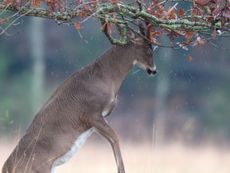 Deer Rubbing Tree Bark: Protecting Trees From Deer Rubs
Deer Rubbing Tree Bark: Protecting Trees From Deer RubsDeer are majestic creatures when they're bounding through open fields and frolicking in someone else's woods. When they come into your yard and start damaging trees, they become something else entirely. Learn more in this article.
By Kristi Waterworth